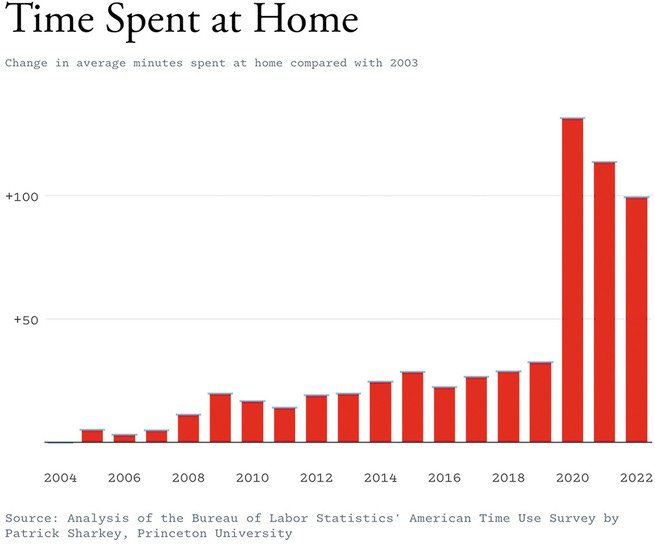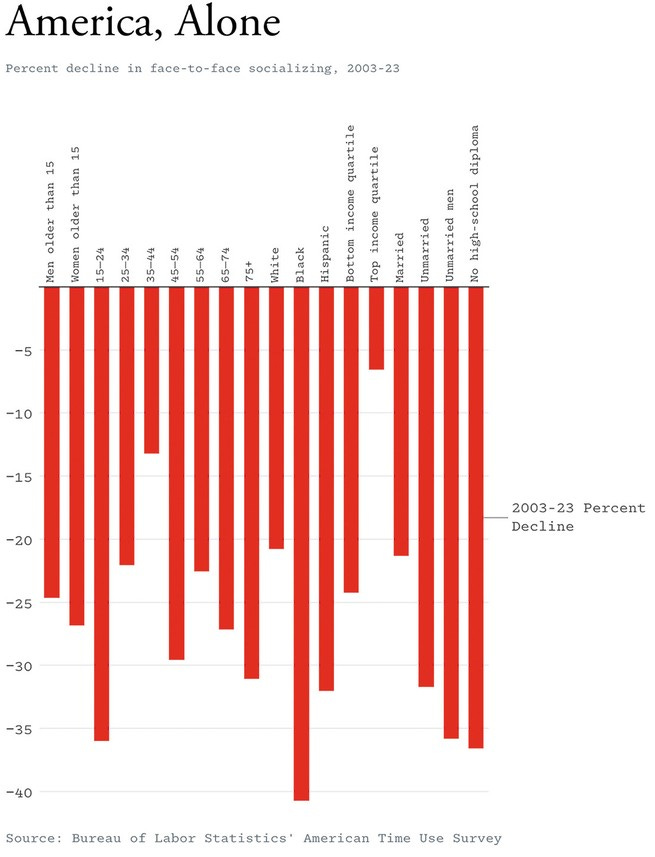I’ve been jolted by some recent reporting on loneliness. I want to jolt you too.
Until recently, evidence on loneliness was rather weak, but a spate of new surveys show a shocking increase in loneliness, particularly among high school kids. Fresh data from 2024 also shows a shocking rise in loneliness among twenty-somethings in the US, UK and Europe.
Perhaps not surprisingly, trends in time spent alone closely mirror trends in mental health, with skyrocketing rates of mental distress among young people (but not necessarily among middle-aged or older adults). Extensive research indicates this is not just a coincidence but a causal relationship. Spending more time alone is strongly linked to reduced life satisfaction and even an increased risk of mortality.
Over the past decade, young people have gradually stepped away from activities that offer genuine fulfillment, substituting them—knowingly or not—with less satisfying alternatives. Last week in the Financial Times, John Burn-Murdoch suggested that like the proverbial frog in slowly heating water, the harm may seem too subtle to notice in the moment, but after several years in the pot, we have reached a boiling point.
Burn-Murdoch’s thinking echoes Derek Thompson’s feature story in the February edition of The Atlantic. I follow Thompson’s byline closely, I admire his thinking about contemporary work culture, I dig his podcast, I trust his journalistic integrity, and I was thrilled to once again see his name on the cover of The Atlantic. In short, Thompson concludes that we are living in the “Anti-Social Century.”
I’ve been thinking about the proposition of the Anti-Social Century. Perhaps ironically, I’ve enjoyed several illuminating conversations with friends, colleagues and students. I’ve grappled with the antithesis. And I’ve sat quietly, alone but not lonely, with the data.
I want to share some of Thompson’s data with you. I urge you to sit with it but, much more importantly, to discuss it with friends and family. Whatever you make of the data, this is a critically important conversation.

Those bar graphs speak volumes. Thompson also offers these equally illuminating data points:
Americans spent even more time alone in 2023 than they did in 2021.
The typical person is awake for about 900 minutes a day. American kids and teenagers spend, on average, about 270 minutes on weekdays and 380 minutes on weekends gazing into their screens.
Teen anxiety and depression are at near-record highs: The latest government survey of high schoolers, conducted in 2023, found that more than half of teen girls said they felt “persistently sad or hopeless.”
In 2022—notably, after the pandemic had abated—adults spent an additional 99 minutes at home on any given day compared with 2003.
The share of U.S. adults having dinner or drinks with friends on any given night has declined by more than 30% in the past 20 years.
Solo dining has increased by 29% in just the past two years. The No. 1 reason is the need for more “me time.”
In 2023, 74% of all restaurant traffic came from “off premises” customers—that is, from takeout and delivery—up from 61% before COVID, according to the National Restaurant Association.
Today, the typical American adult buys about three movie tickets a year—and watches almost 19 hours of television, the equivalent of roughly 8 movies, on a weekly basis.
Here are a few short, suggestive passages from Thompson’s 7500-word piece that shook me:
Self-imposed solitude might just be the most important social fact of the 21st century in America.
People often don’t know what they want, or what will make them happy.
Day to day, hour to hour, we are choosing this way of life—its comforts, its ready entertainments. But convenience can be a curse.
Thompson concludes with this challenge to his readers:
We should ask ourselves: What would it mean to select technology based on long-term health rather than instant gratification? And if technology is hurting our community, what can we do to heal it?
If you’re going to heed my advice and discuss the loneliness epidemic, you might be wise to make space for Thompson’s two questions.
Those questions would make for an easy and fitting conclusion to this edition of The Junction. But in the spirit of TL;DR that seems to be sweeping through Substack, I want to share some data published in the abovementioned Financial Times piece.


Have I piqued your interest? Would you like yet more one-sided discussion of it? Cool Here is a short (18 minute) clip of Thompson walking our pals at PBS through his thinking.
If you want yet more, and I hope you do, I really dig this episode of Thompson’s Plain English podcast. He interviews one of the key sources for his Atlantic piece, University of Chicago psychologist, Nick Epley. Put this in your ears.
Thompson and Epley are hardly alone in their concerns. Last month, as U.S. Surgeon General Vivek Murthy wrapped up his tenure in office, he prioritized his jaw-dropping Surgeon General’s report: Our Epidemic of Loneliness and Isolation. His "parting prescription" to the American people is to prioritize building stronger communities.
“Today, we are faced with a profound choice: do we continue with the status quo, marked by pain, disconnection, and division? Or do we choose a different path—one of joy, health, and fulfillment, where we turn toward each other instead of away from each other; where we choose love over fear; where we recognize community as the irreplaceable foundation for our well-being?…As I finish my tenure as Surgeon General, this is my parting prescription, my final wish for all of us: choose community.”
-Dr. Murthy’s Parting Prescription for America
If you’re not an American-based Junction reader and you’re thinking, “oh well. Sorry America, not my problem,” first of all, you’re an unsympathetic prick. We’re talking about mental health and kids here. Secondly, you might note that the UK now has a minister for loneliness, as does Japan. Loneliness has gone global.
Now in the spirit of being fair and balanced, a spirit that may or may not be overrated (see what I did there), Faith Hill, also at The Atlantic, speaks to The Myth of a Loneliness Epidemic. She argues that this is hardly America’s first loneliness panic. Loneliness is probably not worse now than it has been throughout history. Besides, we don’t exactly know what loneliness is; different people define and experience it differently. We can be alone together and feel together alone. In fact, “measuring isolation isn’t a good way to track loneliness.” I reckon there’s some truth to all these arguments.
While I think Faith makes a good-faith rhetorical argument, Thompson’s deployment of solid evidence makes me, to say the least, concerned about living in an Anti-Social Century.
As always, the comments page is open. I’m curious how you respond to the data. More importantly, I urge you to discuss this trend in your communities. But most importantly, if you’re feeling lonely, please reach out to your people. If I’m your people, please reach out to me. We’re better together. Stay connected y’all.
Love,
DL
Hey! If you enjoyed this piece, you’ll love this one from last year. It’s the most read and most shared edition of my Substack. And if you like either or both of these, please subscribe. Free or paid.
Sensitive, Not Resilient?
On Monday I listened to an interview with Dr. Jean Twenge, a professor of psychology who researches generational differences and is perhaps best known for her book, iGen.








Good point. I might use this in class. Grazie.
Shocking to hear of this...grateful my grandkids r too busy and socially oriented to experience loneliness...I often encourage 📚 to read and befriend in their world...regards Aunt Sheryl in the USA